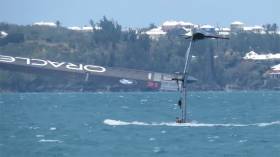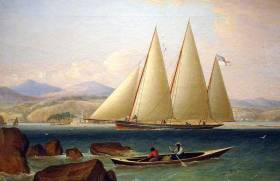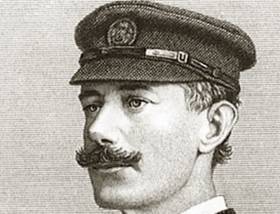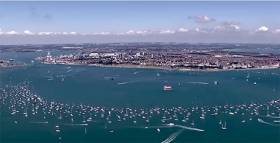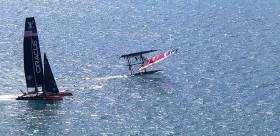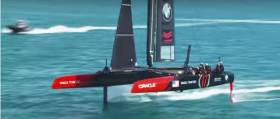Displaying items by tag: America's cup
Despite some interruptions from either too much or too little wind, the regular club sailing programme for 2017 is now fully under way, and this weekend is additionally so well filled with major regional and national events that you could be forgiven for thinking it’s high summer already. W M Nixon tries to make sense of it all.
How on earth is anyone expected to fully understand, let alone explain, a global activity which today sees the extraordinary 1,500 boat Festival of Sail in the Morbihan in France putting in its final races and fleet manoeuvres, before everyone joins in the end-of-show Parade of Sail tomorrow?
Yet at the same time, across the Atlantic in Bermuda, the first moves in the 35th edition of the America’s Cup, arguably the world’s oldest international sporting contest as it goes back to 1851, are getting under way, involving sailing machines for which the word “boat” seems somewhat inappropriate.
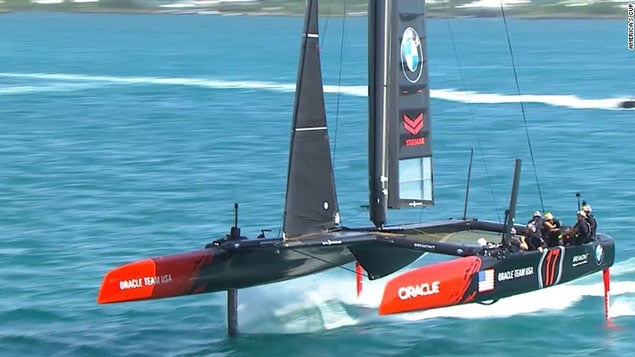 It’s difficult to think of them as anything other than “sailing machines,” but America’s Cup rules reckon they are boats
It’s difficult to think of them as anything other than “sailing machines,” but America’s Cup rules reckon they are boats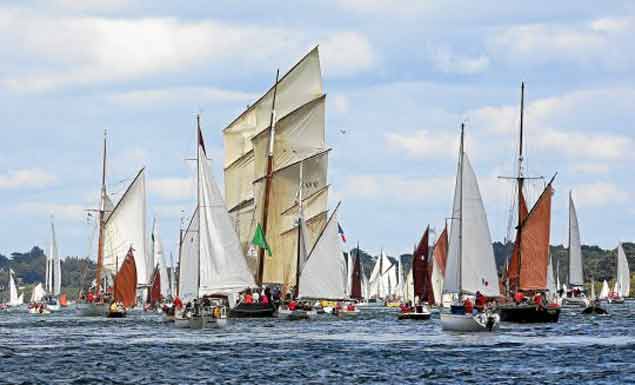 Some of the huge fleet at the current Morbihan festival. In their midst is the bisquine-rigged La Cancalaise from Cancale. In the days of piracy, smuggling and privateering in the English Channel, it was reckoned that any vessel setting this demanding high-performance rig was up to no good, and therefore a legitimate target for government ships
Some of the huge fleet at the current Morbihan festival. In their midst is the bisquine-rigged La Cancalaise from Cancale. In the days of piracy, smuggling and privateering in the English Channel, it was reckoned that any vessel setting this demanding high-performance rig was up to no good, and therefore a legitimate target for government ships
Then too, the world sailing community is still digesting the revelation that future generations of boats in the Volvo World Race, which now rivals the America’s Cup for international attention, will be in effect IMOCA 60s with mega-foils.
And in addition to that, at each in-harbour stopover, the world-girdling Volvo Ocean Race crews will be expected to do a series of races in smaller but very potent multi-hulls which will thrill spectators with their closeness to the watching crowds and to each other, with hair’s breadth misses – and ideally the occasional not-too-serious shunt - a central part of the action.
All these major international events then have to be fitted around the reality that, like it or not, sailing is one of those minority sports that need the Olympics more than the Olympics need sailing. In other words, we have to keep the decks clear of other major international fixtures to give total attention when the next sailing Olympiad at Tokyo comes along in 2020.
For those who would snort in derision at such a suggestion, do tell us what you were doing (if you can remember) while the rest of Ireland held its breath and watched as Annalise Murphy was sailing towards her Silver Medal on August 16th 2016?
Nevertheless, having taken all that into account, the reality is that the top end of sailing is reaching ever-higher peaks of performance in everything, and inevitably using boats and equipment of unimaginable expense. So except for the Morbihan event - whose ethos is found in going the other way, with total democratic involvement for everyone - how on earth can ordinary sailors relate to what the participants in the America’s Cup and the Volvo World Race are experiencing?
Let’s be honest. We can only do so - if at all - with some mighty leaps of the imagination. The result is that many of us are going back to the knitting. We’re going back to trusted events, and staying with sailing boats which may not be in the first flush of youth, but at least they mean something to us.
We know that with them, we can find racing which bears some relation to everyday life rather than the other-world dreamscape which is the America’s Cup or the Volvo World Race.
Over the next two weekends in Ireland, this racing of familiar boats will move up a couple of gears, as this weekend is the Bank Holiday in the North, and in a week’s time the extra day off is in the Republic. So keen sailors who see their programme on an all-Ireland basis somehow manage to convince themselves that we have two all-island Bank Holidays on the trot.
 Galway hookers gather at the Claddagh, while above them is the Galway City Museum, currently staging a Marine Science Exhibition.
Galway hookers gather at the Claddagh, while above them is the Galway City Museum, currently staging a Marine Science Exhibition.
Thus the ongoing Claddagh Festival with all varieties of Galway Hookers on show in the City of the Tribes is also managing to welcome Viking longships which have been brought overland from their home port of Ardglass in County Down. And at least the northerners have the proper claim that, for them, Monday is a free day to get their boats home again.
That equally applies to northern visitors to the Woodenboat Festival in Baltimore, which got going last night and should have good weather from midday onwards today, and through tomorrow’s colourful programme. Nevertheless for those with a day job to think about, the long haul home on Sunday night can become very long indeed.
 Baltimore in West Cork - the perfect location for a friendly Woodenboat Festival
Baltimore in West Cork - the perfect location for a friendly Woodenboat Festival
 It’s not quite racing, but when a Galway hooker (left) finds competition at Baltimore Woodenboat Festival with a traditional West Cork boat, there’s certainly an added edge to the sailing. Photo Sheena Jolley
It’s not quite racing, but when a Galway hooker (left) finds competition at Baltimore Woodenboat Festival with a traditional West Cork boat, there’s certainly an added edge to the sailing. Photo Sheena Jolley
Both these events are traditional annual festivals in which racing plays only a small – if any – part. But even in competitive sailing, all the signs are that people are returning to beef up the numbers and competition in events which served them well in the past, yet had slipped in the popularity ratings owing to a change in behavioural patterns (the modern family is an extremely demanding taskmaster), and the ill-effects of the economic recession.
Everyone has been heartened by the new strength of the Irish Sea Offshore Racing Association (to which we’ll return in a minute), but today the top of the agenda is the Scottish Series, getting up to speed at the lovely little port of Tarbert on Loch Fyne. Of course, numbers are nothing like the eventually unmanageable crowd of boats which became a feature of this series about twenty years ago. But nevertheless there’s a tidy fleet at Tarbert, and a strong Irish contingent are in with more than shout of bringing home the big prize.
 Packing them in – the Scottish Series fleet in Tarbert
Packing them in – the Scottish Series fleet in Tarbert
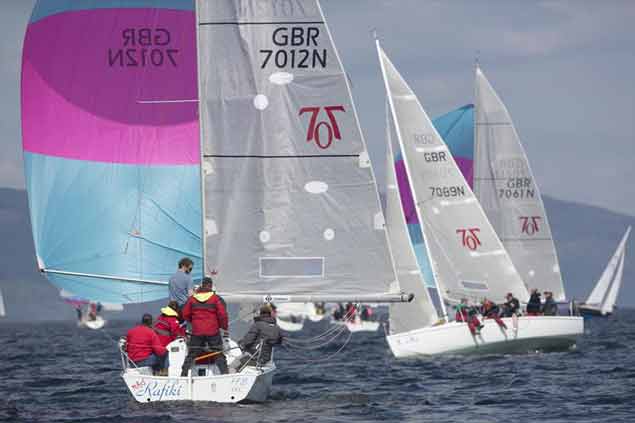 The Hunter 707 fleet provided some of the best racing at last year’s Scottish Series
The Hunter 707 fleet provided some of the best racing at last year’s Scottish Series
 Dara O’Malley (second left) and his winning crew on Seaword, which made him Afloat.ie “Sailor of the Month” for May 2016. Photo: Marc Turner
Dara O’Malley (second left) and his winning crew on Seaword, which made him Afloat.ie “Sailor of the Month” for May 2016. Photo: Marc Turner
Last year it was one of the diaspora, Dara O’Malley originally from Westport but now sailing on the Firth of Forth with his Hunter 707 Seaword, who was tops. While he may be Scottish-based, he was home among us in January to receive his Afloat.ie “Sailor of the Month” Award for May 2016 at the National Sailing Awards in the RDS.
He is defending this weekend, and another former overall winner is the irrepressible Rob McConnell from Dunmore East. With an almost entirely Waterford Harbour SC crew, Rob’s A35 Fool’s Gold is reportedly in particular good trim this year, so definitely a boat to watch.
Other strong performers from Ireland over in Tarbert include the Kelly family from Rush with their J/109 Storm, and that highly individualistic helmsman renowned for pulling rabbits out of the hat, Johnny Swan with his classic Half Tonner Harmony from Howth. Strangford Lough is sending the notably steady perfomer Jay Colville with his successful First 40 Forty Licks, while all the way from Cork Harbour is the First 36.7 Altair (K Dorgan & J Losty) of Cove Sailing Club, recalling the enthusiasm of a high order which used to be a feature of the O’Leary family’s years with the Corby 36 Antix from Crosshaven, an overall winner in Scotland on more than one occasion.
 They might do it again......Rob McConnell (fourth left) and his mostly Dunmore East crew after winning the Scottish Series in 2015 on the Archambault 35 Fool’s Gold. Photo: Marc Turner
They might do it again......Rob McConnell (fourth left) and his mostly Dunmore East crew after winning the Scottish Series in 2015 on the Archambault 35 Fool’s Gold. Photo: Marc Turner
The continuing growth of the J/109s, which have needed ten years to become an overnight success in Ireland, is shown by the additional presence in Scotland of two of Storm’s sister-ships from home, Andrew Craig’s Chimaera and John & Brian Hall’s Something Else, while a smaller manifestation of the J Boat range’s ubiquitous nature is the participation of Stephen Quinn’s J/97 Lambay Rules from Howth.
It’s an interesting crew setup, as Lambay Rules’ core team, including Stephen Quinn himself, have been seen racing in the elegance of Stephen O’Flaherty’s Spirit 54 Soufriere, whose claims to fame include a role in a James Bond movie. Despite the obvious differences between the two boats, the key personnel – including Stephen O’Flaherty – moved aboard the little Lambay Rules for last year’s Volvo Round Ireland Race, and despite being one of the smallest boats in the fleet (in fact, I think she was the smallest), at several stages they were leading their class, but not alas at the finish.
Their determined involvement in Scotland says much for their continuing zest in the game, but meanwhile back home the presence of so many significant boats over in Scotland has done little to diminish numbers for this morning’s ISORA Race from Dun Laoghaire to Arklow, which will see 28 starters.
PHOTO HERE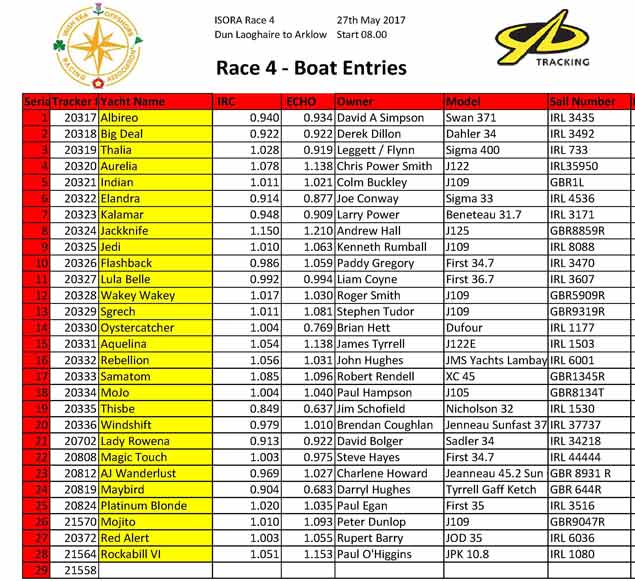 The lineup for today’s ISORA-Dun Laoghaire Race
The lineup for today’s ISORA-Dun Laoghaire Race
Very senior ISORA contenders have a feeling that they must have raced to Arklow before, but maybe they’re confusing it with ISORA races which took in the Arklow Lightvessel as a mark of the course, and it’s undoubtedly a very long time since a lightship was on the Arklow Bank.
Certainly ISORA Chairman Peter Ryan says that this is the first time an ISORA Race has finished in Arklow, where the local sailing club has been expanding in a healthy style, while on the bigger canvas, the Tyrrell family with their succession of ever-larger and successful craft in the J Boat range – all called Aquelina – has done much to have Arklow SC punching way above its weight on the national offshore racing scene.
The Tyrrells were too far ahead of the curve when they got their first Aquelina, a J/109, shortly after the new marque was introduced. Their hopes of getting a semi-One-Design J/109 class going didn’t take off. But today, racing their current J/122E Aquelina back to their home port, they’ll ruefully observe that there are at least five J/109s racing with them, a goodly number when we remember that three of the Dublin class are in Scotland, and several others are staying in Dun Laoghaire to do today’s Dublin Bay SC race.
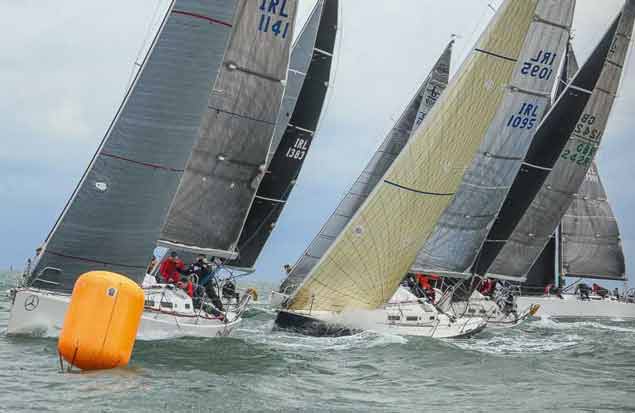 It has taken them ten years to become an overnight success, but the J/109s are now a very significant presence in Dublin Bay. Photo: Afloat.ie
It has taken them ten years to become an overnight success, but the J/109s are now a very significant presence in Dublin Bay. Photo: Afloat.ie
However, one of the latest J/09s to join the Greater Dublin class is Indian, owned by Colm Buckley and Simon Knowles of Howth. They won the two-handed class in the 2015 Dun Laoghaire to Dingle race in the smaller Elan Blue Eyes, but this race to Arklow is their first serious offshore challenge in the J/109. It will be a proper test, as the J/109 contingent includes Peter Dunlop’s Mojito and Stephen Tudor’s Sgrech, both from Pwllheli and respectively first and second of the J/109s in the Holyhead to Dun Laoghaire race a fortnight ago.
But the boat for everyone to beat is Paul O’Higgins’ JPK 10.80 Rockabill VI, whose remarkable all-round ability was demonstrated with the overall win in the increasingly breezy Holyhead-Dun Laoghaire Race of May 13th. These JPK 10.80s are superb performers across a wide range of conditions, and the simple fact of knowing they have such a good boat under them is an added encouragement for Paul O’Higgins and his crew of all the talents.
The highly technical approach of racing a boat like Rockabill VI is a whole world away from the intimate world of wooden boat adherents getting together in Baltimore, or the historical, cultural and music-laden gathering of the traditional craft and their visiting Vikings in Galway. But that’s the way it is in the very wide world of boats and sailing. In the end, we’re all members of the same exceptionally diverse sailing community.
 The boat to beat – Paul O’Higgins JPK 10.80 Rockabill VI is a superb all-rounder
The boat to beat – Paul O’Higgins JPK 10.80 Rockabill VI is a superb all-rounder
#AmericasCup - Team Oracle USA have their work cut out for them after their second capsize in as many months during training for the America's Cup in Bermuda this week.
Sail-World has the full report on the latest incident, which occurred when the team’s AC50 catamaran went into a roll at high speed after a foiling gybe.
The team confirmed no injuries to the crew and only limited damage to the vessel in the capsize this past Wednesday 10 May.
But it can’t be good for morale among the defending Auld Mug holders, coming so soon after capsize trouble a month previously.
No other AC50 has capsized in preparation for the qualifiers later this month – including Land Rover BAR, which is skippered by Sir Ben Ainslie, the man who turned around Oracle’s fortunes for their shock victory in 2013.
Sailing's Gaff Rig: Ireland's Part in its Downfall
The 35th staging of international races for the 176-year-old America’s Cup is rising rapidly up the agenda. The opening jousts for challengers begin on 26th May 2017 at the first-time-selected venue of Bermuda, and the cup series itself starts there on 17th June. It’s time to focus on the sailing paradise of Bermuda, and particularly its role in changing the shape of sails in mainstream sailing. W M Nixon takes a typically skewed look at what it all might mean.
The irony of it is that, long before the rig was popularly accepted, it was the sailors of Bermuda who were credited with the invention of the jib-headed triangular shape for mainsails. This dominated yacht design for nearly a century. Yet in 2017, as the inevitably trend-setting America’s Cup finally comes to Bermuda for the first time, it will be raced by sailing machines – the word “boats” seems inadequate – which are setting what looks very like an extremely modern variation of the classic gaff rig.
For what are today’s state-of-the-art square-headed mainsails other than an attempt to get as much sail area as possible within the limits set by the height of the mast and the length of the boom? And what rig was based on the same premise? Exactly. The gaff rig, and its very useful cousin, the sprit rig.
 Is this or is this not gaff rig? America’s Cup defenders Oracle in action off San Francisco
Is this or is this not gaff rig? America’s Cup defenders Oracle in action off San Francisco
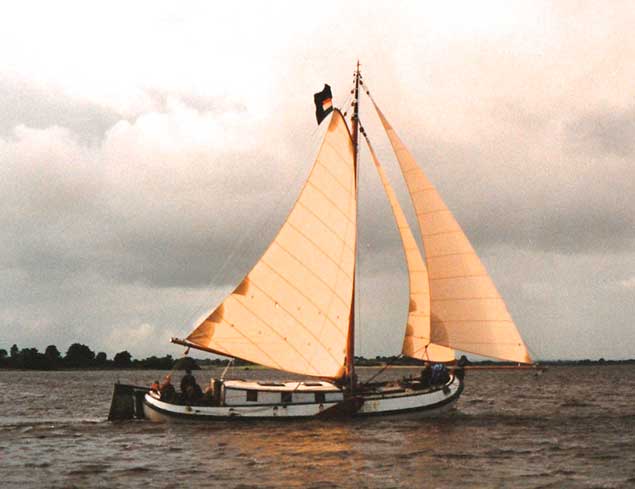 David Beattie’s Dutch Lemsteraak Schollevaer, sailing here on Lough Ree, indicates that classic Dutch yachts tended towards shortening their gaff booms to such an extent that for a period they were almost Bermudan rigged. Photo: W M Nixon
David Beattie’s Dutch Lemsteraak Schollevaer, sailing here on Lough Ree, indicates that classic Dutch yachts tended towards shortening their gaff booms to such an extent that for a period they were almost Bermudan rigged. Photo: W M Nixon
Yet at a certain stage, as the pioneering Dutch yachtsmen moved from the sprit rig to the gaff rig, the gaff booms became so short that the sailing world was very close to having jib-headed mainsails. But boats setting bisquine rig or something very similar showed what could be done with topsails, and longer gaff booms with topsails above them became the norm.
In due course, the logic of having lighter masts, and mainsail and topsail one and the same with no booms between them, became inescapable. Yet because so many people, relatively speaking, had by this time taken up sailing, the arguments about which rig, gaff or Bermudan, was superior soon became ludicrously heated.
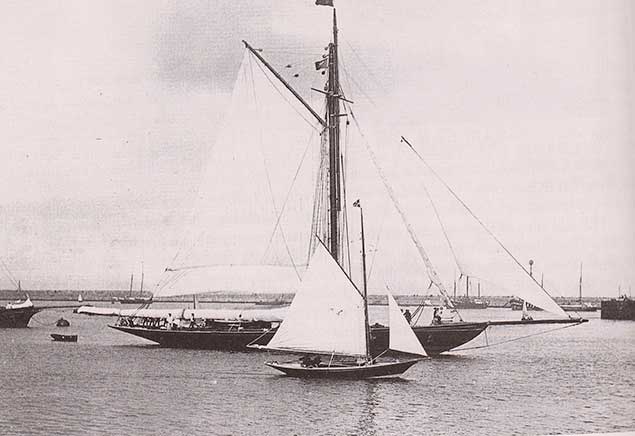 The Prince of Wales cutter Britannia in Dun Laoghaire in 1893, newly-built and on passage from the Clyde to the Solent, showing how a racing gaff rig could be shortened down for sea-going passages in heavy weather, with the topmast safely housed and a loose-footed gaff-headed trisail set instead of the full mainsail.
The Prince of Wales cutter Britannia in Dun Laoghaire in 1893, newly-built and on passage from the Clyde to the Solent, showing how a racing gaff rig could be shortened down for sea-going passages in heavy weather, with the topmast safely housed and a loose-footed gaff-headed trisail set instead of the full mainsail.
Traditionalists argued that while Bermudan rig might be just about acceptable for inshore racing in sheltered water, anyone going cruising or racing offshore needed the rugged gaff rig with its compact mast, possibly heightened by a topmast which could he lowered and housed against the forward side of the mainmast when at sea and conditions deteriorated.
And then there were and still are the uber-traditionalists who argue that if gaff rig had been good enough for their fathers and forefathers before them, then it was good enough for them, and you don’t have to go any further than Howth, Connemara or Falmouth to find them in their droves.
A new factor entered the equation with the development of the heritage industry, which concluded that that the loss of familiarity with handling the formerly-universal gaff rig was a real cultural threat. So in 1963 the Old Gaffers Association came into being at much the same time as the Classic Yacht Movement was starting to gain traction, and thus the preservation of gaff rig was being upheld from both ends of the wealthy to barely-getting-by spectrum.
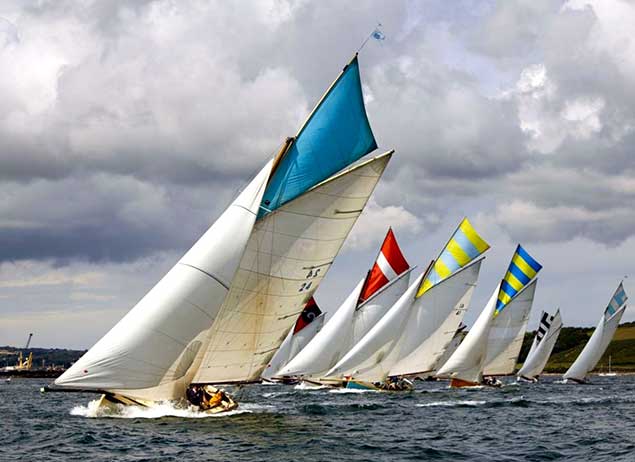 Where gaff rig is the norm – Falmouth Working Boats racing. Under ancient legislation, it is only permissible to dredge for oysters in Falmouth Harbour under sail, and the working boat with adjustable performance has developed as a result.
Where gaff rig is the norm – Falmouth Working Boats racing. Under ancient legislation, it is only permissible to dredge for oysters in Falmouth Harbour under sail, and the working boat with adjustable performance has developed as a result.
It was all great fun if you didn’t take it took seriously, but in its day, some people took it very seriously indeed and a few still do, so we’ll give the pot a very good stir by revealing that it was Irish sailors who played a key role in making Bermudan rig mainstream.
Our header image reveals that Bermudan rig in a quite sophistcated form was not unknown from 1834 onwards. But nevertheless even in crack yachts like Belfast linen magnate John Mulholland’s schooner Egeria of 1865 vintage, and John Jameson of Dublin’s cutter Irex designed by Alexander Richardson in 1884, the relatively crude gaff topsails being set still showed how closely they were descended from lug rigs which in turn had evolved from trying to get simple squaresails to set closer to the wind.
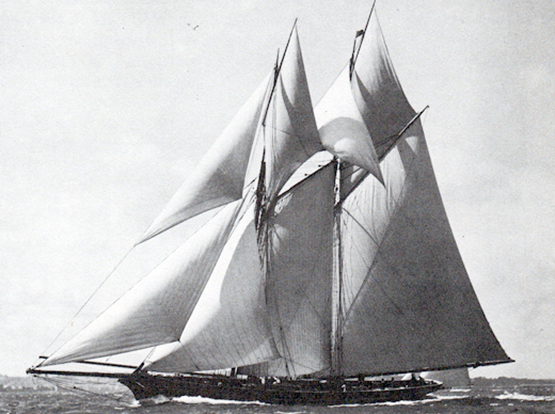 John Mulholland’s 99ft schooner Egeria of 1865 vintage set topsails which were developments of lug sails
John Mulholland’s 99ft schooner Egeria of 1865 vintage set topsails which were developments of lug sails
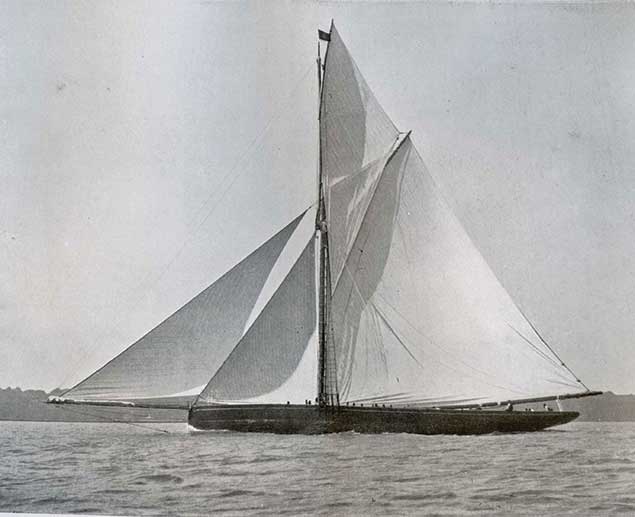 John Jameson’s Irex of 1884 originally set a topsail which looked very out-of-date just ten years later
John Jameson’s Irex of 1884 originally set a topsail which looked very out-of-date just ten years later
But by the late 1880s, topsails were becoming more clearly jib headed, and for a while they used a combination of short mainmast, a short topmast, and a topsail yard to provide their height, which could resulted in a distinctly stunted look when on a dead run, as is seen in the Scottish ironmaster Peter Donaldson’s all-conquering 70ft 40-rater Isolde, designed and built by Fife in 1895.
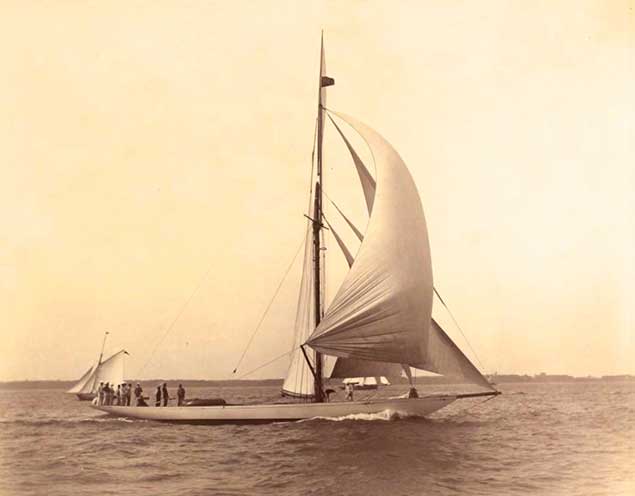 Fast boat, dumpy rig? Peter Donaldson’s successful Isolde of 1895 looked to have a very low-slung rig when she squared off on the run
Fast boat, dumpy rig? Peter Donaldson’s successful Isolde of 1895 looked to have a very low-slung rig when she squared off on the run
It is the famous photo of the new Belfast Lough 25ft One Designs at their start in the RUYC Regatta in July 1898 - their second season – which best shows how gaff rig had developed in the decade since Irex was the boat to beat. The BLOD 25’s have topsails which use long yard to sit as flush as possible with the mast. As the luff length of the topsail was actually longer than the luff length of the mainsail, and as it is luff length which does most of the work in making to windward, getting the topsail and mainsail to set as one was vital in achieving best performance.
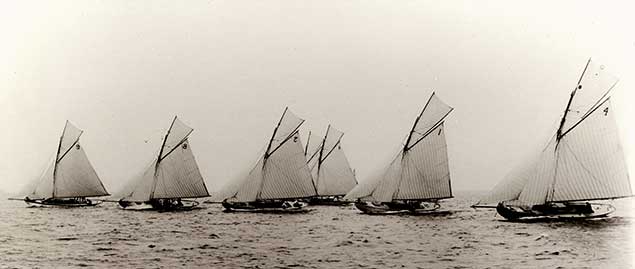 Serious topsails. With a luff length longer than the luff length of the mainsail, the Belfast Lough 25ft ODs had to get the set of their topsails just right.
Serious topsails. With a luff length longer than the luff length of the mainsail, the Belfast Lough 25ft ODs had to get the set of their topsails just right.
In fact, as I learned in my days of racing a Howth 17, fractions of an inch in the location of the topyard halyard and jackyard outhaul on their respective yards made all the difference between having a very effective topsail, and having a heap of rubbish aloft which was only holding you back if the wind freshened on the final leg. You were getting there if, when setting the sails, you could look aloft and see the newly-hoisted topsail set as flat as a board, with even tensions to every corner. This meant that you could ease the mainsail peak halyard just a smidgin to transfer some of the load directly to the topsail, thereby making mainsail and topsail in effect into one sail which happened to have a couple of bits of wood in the middle.
However, despite the favourable impact made by boats such as Isolde and the BLOD 25s, larger yachts tended increasingly to revert to long topmasts in order to make their topsails more effective, and in the most enthusiastic cases, the mastman would be despatched aloft to lace the luff of the topsail to the topmast and the mast itself. This certainly achieved an efficient set for the sail, but was unseamanlike in the extreme, as it totally obviated the topsail’s supposed benefit of being able to reduce sail area aloft in only a few minutes.
Surprisingly enough, it wasn’t until 1912 that designer Charles E Nicholson was allowed by an owner to do away with the cumbersome, eddy-inducing topmast altogether, simply by extending the mainmast in the lightest possible section in a 12 Metre.
Naturally the critics expected the new unfeasibly tall masts to break under the load of the topsails, and some of them did just that. But those tall continuous masts that stayed aloft tended to win races, and so the Marconi mast was here to stay. They were nicknamed “Marconi” masts in acknowledgement of the high aerials required by Italian radio pioneer Guglielmo Marconi (1874-1937), whose mother was a Jameson and whose first radio report of a sporting event was the Royal St George YC Regatta of 1904 in Dublin Bay.
It was only two years after the first Marconi sailing mast appeared in a yacht that the first international racing yacht took the next logical step of making the topsail and mainsail into one, and that yacht was newly-commissioned in 1914 from Fife of Fairlie by an Irish yachtsman, Arthur F Sharman Crawford, Commodore of the Royal Munster Yacht Club on Cork Harbour.
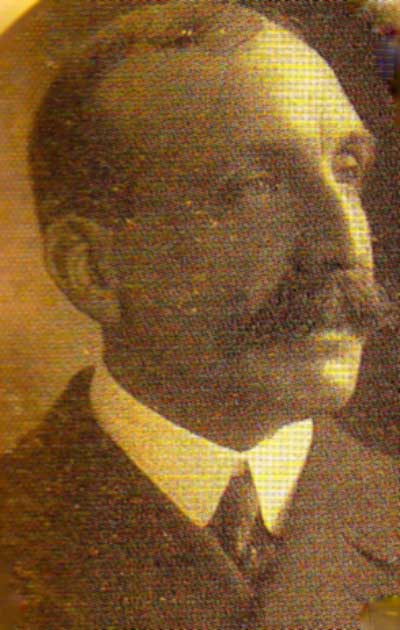 Man of many talents and interests – Arthur F Sharman Crawford contributed much to his adopted home of Cork
Man of many talents and interests – Arthur F Sharman Crawford contributed much to his adopted home of Cork
There’s a book to be written about Arthur F Sharman Crawford (1862-1943), for there’s no way that even a dozen blogs could explain how the Dublin-born English-educated younger son of a northern family with extensive land-holdings in County Down – particularly on the shores of Belfast Lough – came to be the Managing Director of Beamish & Crawford’s brewery in Cork. There, he joined the management team at the age of 28 in 1890, and guided it as Managing Director through some of its most successful periods, and also skillfully negotiated the difficulties of World War 1, the Easter Rising, the War of Independence and the Civil War in a total period from 1914 to 1923, while at the same time being a great benefactor to his adopted city, particularly in the area of technical education, but also in the broader cultural and artistic sphere.
Yet this was no unduly serious do-gooding workaholic. On the contrary, Arthur Sharman Crawford (the family preferred their double surname without a hyphen) was sports mad. A keen yachtsman who was an early owner in the Cork Harbour One Designs of 1896, he was elected Commodore of the Royal Munster YC when it was still at Monkstown in 1898. When it moved to Crosshaven in 1923, as he lived at Lota Lodge in Glanmire north of the harbour, he transferred his full allegiances to the more conveniently located Royal Cork at Cobh where he was already Vice Admiral, and in 1925 he became Admiral and served in that post until 1935.
He also rode to hounds every winter with ferocious enthusiasm, being Joint Master of Cork’s United Hunt for four years. And in later life he played a central role in the establishment of Cork Golf Club, where he served as an actively and frequently-playing President for many years. But in his prime, sailing was his main sport, and he spread his wings far beyond Cork Harbour, for he campaigned on the international scene with a Fife 12 Metre called Ierne, and as a member of many yacht clubs throughout Ireland and Britain, he was a frequent guest helm at regattas, with particularly close associations with the Royal Ulster YC on Belfast Lough.
There, his older brother Robert was Vice Commodore and chaired the committee which oversaw the five challenges for the America’s Cup by Thomas Lipton, the first in 1899 and the last in 1930. The advice of the widely-experienced Arthur was regularly sought by this committee. Yet in other areas of life, there was a parting of the ways between the two brothers. In a time of political restlessness, the northern-based Robert Sharman Crawford was uncompromisingly unionist, and became an active leader in the Ulster Volunteer Force from 1912 onwards. But in the different mood of Cork, the southern-based younger brother had a more accommodating attitude towards Home Rule, reflected in the fact that he continued to play a public role in Cork life, and all his branch of the family were at their deaths buried in the family plot on Little Island in Cork Harbour rather than in the ancestral family lands at Crawfordsburn in County Down.
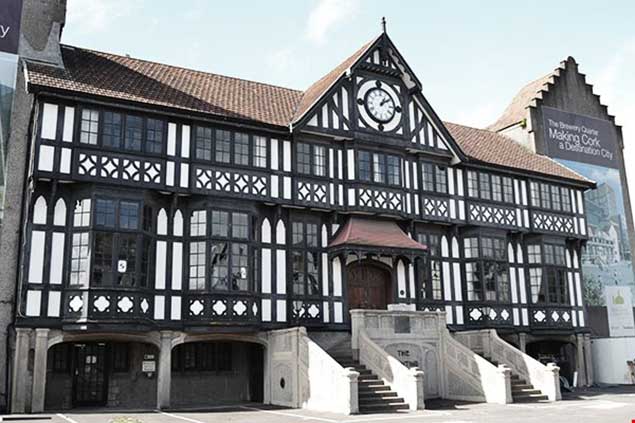 The distinctive Beamish & Crawford Counting House in Cork was built in 1918 during Arthur Sharman Crawford’s long period as Managing Director of the brewery
The distinctive Beamish & Crawford Counting House in Cork was built in 1918 during Arthur Sharman Crawford’s long period as Managing Director of the brewery
There was a very pointed irony in the brothers’ relationship, for even as the brewery in Cork prospered under Arthur’s stewardship, the inherited income from the Crawford estates in the north was shrinking thanks to longterm effects of the activities of Michael Davitt’s Land League and the resultant Gladstone-inspired Land Acts of 1896. The dividends from Cork became an increasingly important part of Robert Sharman Crawford’s income to maintain his opulent lifestyle as a leading yachtsman and as Lord of the Manor of the new loughside Crawfordsburn House, built in the late 1890s to the designs of Vincent Craig. He was the architect brother of Northern Ireland’s future first Prime Minister James Craig (another sailing enthusiast), and his considerable architectural talents were at the same time being deployed for the design of the new Royal Ulster Yacht Club building, which opened in April 1899.
By 1912 and the public declaration of the Ulster Covenant with Robert Sharman Crawford a leading signatory, the fact is that his way of life was largely supported by Beamish & Crawford dividends. It seems only ironic in hindsight – at the time, everyone on all sides though they were doing the right thing. It is only in looking back from the distant and safe viewpoint of 2017 that we realise how curious it was that 104 years ago in 1913, when Colonel Robert Sharman Crawford put his own-funded brigade of the Ulster Volunteer Force through their parades, manoeuvres and exercises on the lawns and fields of Crawfordsburn House, it was all being largely paid for by the continued devotion of the Beamish stout drinkers of Munster.
Yet in that dreamlike pre-World War I era, such activities still seemed slightly theatrical and unreal, and normal life went on at an even more determinedly enthusiastic pace than ever. Having finally agreed a Measurement Rule with the defenders, early in 1914 Thomas Lipton’s latest America’s Cup Challenger, the Charles E Nicholson-designed Shamrock IV, was nearing completion in the south of England. And in the Fife yard in Fairlie in Scotland, a new William Fife designed yacht with an experimental rig was under construction for Arthur Sharman Crawford.
For although Lipton’s technically advanced Shamrock IV carried a very sophisticated gaff rig, it was a gaff rig nevertheless. Thus Arthur Sharman Crawford’s new boat was more important in terms of overall technological development. A more manageable 8 Metre after several successful but demanding years with the 12 Metre Ierne, the new Ierne II was the first yacht to the International Rule of 1907 to set a Bermudan rig.
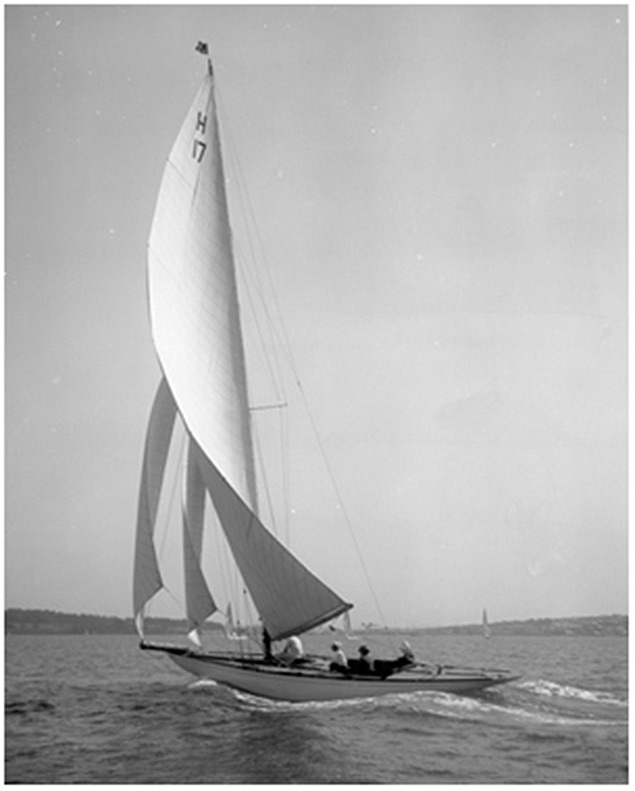 Arthur Sharman Crawford’s 8 Metre Ierne II in 1914, when she was the first International Rule yacht with Bermudan rig.
Arthur Sharman Crawford’s 8 Metre Ierne II in 1914, when she was the first International Rule yacht with Bermudan rig.
Why is she almost totally forgotten in Ireland? Well, Arthur Sharman Crawford led a sort of sailing double life, or even treble life. At home in Cork Harbour, his sailing was local, often using local boats. On Dublin Bay and particularly in Belfast Lough, he was associated with the Lipton camp. But on the Clyde or in the Solent, he was the international or even supra-national yachtsman Arthur Sharman Crawford, challenging the top talents at a rarefied level which was remote from the more localized approach of Cork Harbour or Belfast Lough, and at a tasteful remove from the razzmatazz of Lipton’s America’s Cup challenges.
So when Ierne II appeared fresh out of the wrappers to surprise everyone in the Solent in July 1914, she had never been anywhere near either Belfast Lough or Cork Harbour. It was in the Solent that she made her debut, and for a few very encouraging weeks, while she was undoubtedly a very different creature to sail than a gaff-rigged boat, she was out-performing them all to windward.
It’s intriguing to reflect that when Ierne II was being admired as the hottest new boat in Cowes in late July 1914, briefly in the same harbour at the same time we would have seen Erskine & Molly Childers’ Asgard and Conor O’Brien’s Kelpie pretending to be leisurely cruisers going gently about their business, when in fact they were bound for the Ruytigen Lightvessel to collect their cargoes of Mauser rifles.
Within a couple of weeks, everyone’s plans were in disarray with the outbreak of World War I. All the key figures in the Asgard/Kelpie adventure quickly found themselves positions with the Allied Forces. As for Arthur Sharman Crawford, at the age of 52 this was not an immediate consideration, but his plans for a new programme of fresh excitement for a keen yachtsman past what was then considered the prime of life simply evaporated. Cowes Week 1914 was cancelled completely, and Ierne II was denied the stage which would have provided the setting to enable her to claim her rightful place in sailing history.
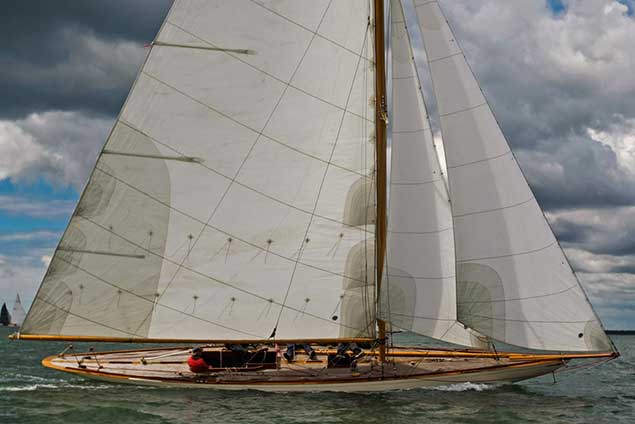 The restored 8 Metre Ierne II is a vivid reminder of Arthur Sharman Crawford’s pioneering instincts.
The restored 8 Metre Ierne II is a vivid reminder of Arthur Sharman Crawford’s pioneering instincts.
Indeed, it was only when noted Yorkshire sailor Hew Jones spotted her laid up in Portugal in 2005 and set about a restoration on Humberside that the whole astonishing story was revealed. When World War II ended in 1918, anyone running a business in Cork amidst Ireland’s growing troubles had other things on his mind, and Arthur Sharman Crawford put Ierne II – laid up since the beginning of August 2014 – on the market. She was eventually bought by Norwegians who wanted a boat for the 8 Metre Class in he 1920 Olympic games in Belgium, and they struck gold in every way, as Ierne II won the Gold Medal.
The top racing sailors were increasingly convinced that Bermudan rig would be where it was at, but in the post war recession, progress was slow. Nevertheless, it was another Irish owner who led the way in the south of England. Elizabeth Workman was the widow of one of the founders of the Workman Clark shipyard in Belfast, and as they at least had done well out of the war, she had the resources to re-commission her 112ft gaff cutter Nyria, designed by Charles E Nicholson and built by Camper & Nicholson in 1906.
Nyria was Solent-based, and following the success of Ierne II and other newly-Bermuda rigged smaller boats in the 1920 Olympics, Elizabeth Workman took the mighty step of getting Charles Nicholson to kit out Nyria with Bermudan rig for the 1921 season, making this the first internationally recognized “big yacht” to do so.
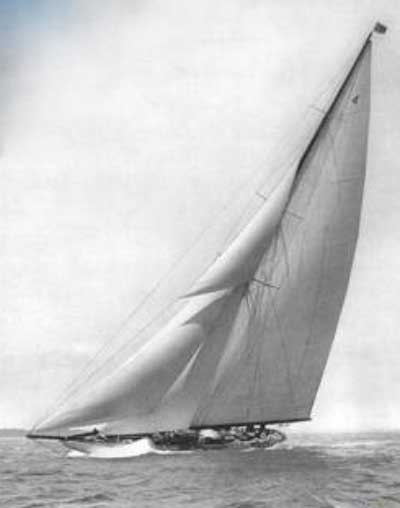 Nyria, owned by Elizabeth Workman of Belfast, in 1921 became the first “big yacht” to be kitted with Bermudan rig
Nyria, owned by Elizabeth Workman of Belfast, in 1921 became the first “big yacht” to be kitted with Bermudan rig
The corner towards Bermudan rig was being turned, and yet another impulse came from Ireland , this time with the commissioning of the world’s first Bermudan-rigged One Design class. The lively Belfast Lough sailing scene of 1914 had been largely destroyed in the trenches of the Somme by the time peace returned in 1918. In an exchange of letters in 1919, some of the more senior members of the Royal Ulster wrote about the need for a new class of boat “which could be sailed by a man and his daughters”. Far from being a gesture for women’s rights, this was simply a sad admission that so many young sailing men would never return from Flanders fields and northern France that it would be 1925 where anything approaching normal manpower levels in sailing would be regained, and so in 1921 the Alfred Mylne-designed Bermudan-rigged 29ft River class made their appearance on Befast Lough. They have never known any rig other than Bermudan, and they continue racing today, though now based on Strangford Lough.
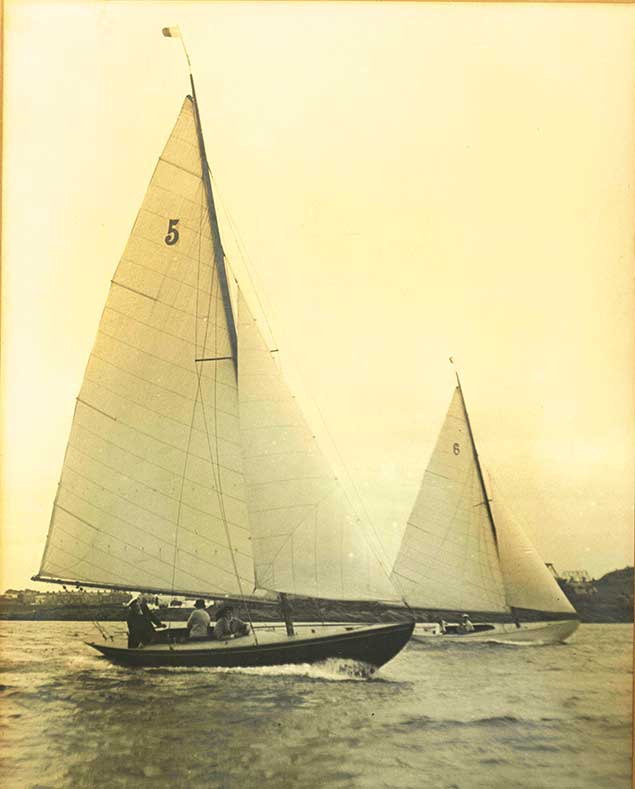 The River Class, seen here racing in Befast Lough in 1921, were the world’s first Bermudan-rigged One Designs.
The River Class, seen here racing in Befast Lough in 1921, were the world’s first Bermudan-rigged One Designs.
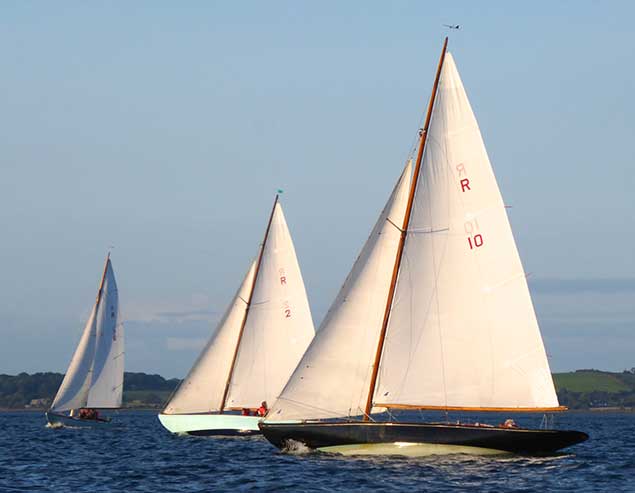 The River Class as they are today in Strangford Lough after 96 years of setting Bermudan rig
The River Class as they are today in Strangford Lough after 96 years of setting Bermudan rig
Thereafter, the move towards Bermuda rig was inexorable and seemingly irreversible, even though sailors as experienced as Billy Mooney of Dublin were ordering the gaff rigged ketch 42ft Aideen to be built by Tyrell’s of Arklow in 1934, and he sailed her so well that he won his class in the 1947 Fastnet Race.
But others were more restless. Since 1898 the gaff-rigged Howth 17s had been sporting their jackyard topsails at their home port north of Dublin, and in 1907 the Dublin Bay Sailing Club adopted the same design, and proprietorially re-designated them as the Dublin Bay 17s. Not only that, but in 1936 a young and competitively successful Dun Laoghaire owner, Terry Roche, decided he would lead the way by converting his DBSC 17 Eileen to Bermudan rig. Despite the fact that she now carried lee helm as he would also have had to move the mast aft to make the new rig balance, he doggedly sailed her to Holyhead and back to prove that all was well. But nobody followed his lead, and after this rather expensive experiment, Eileen reverted to gaff rig and successful racing the following year, and the only lasting memorial of this project is the quaint photo of the Dun Laoghaire waterfront in 1936, a classic image worthy of Cartier-Bresson, with the Water Wags racing off the Royal Irish YC beyond, while in the left of the photo is Eileen sailing under Bermudan rig using mainsail only, which probably balanced quite nicely.
 A quirky photo worthy of Henri Cartier-Bresson. The waterfront at Dun Laoghaire in the summer of 1936, with the Water Wags beyond racing off the Royal Irish YC, and on the left Terry Roche’s Howth/Dublin Bay 17 Eileen in her brief but expensive flirtation with Bermudan rig.Photo courtesy Hilary Keatinge-Roche
A quirky photo worthy of Henri Cartier-Bresson. The waterfront at Dun Laoghaire in the summer of 1936, with the Water Wags beyond racing off the Royal Irish YC, and on the left Terry Roche’s Howth/Dublin Bay 17 Eileen in her brief but expensive flirtation with Bermudan rig.Photo courtesy Hilary Keatinge-Roche
 Howth 17s at Dun Laoghaire again, but this time rigged as nature intended, complete with jackyard topsails. Photo VDLR
Howth 17s at Dun Laoghaire again, but this time rigged as nature intended, complete with jackyard topsails. Photo VDLR
Yet other classes such as the Belfast Lough Island class yawls changed to Bermudan rig in the 1930s, but in Dublin Bay the honour of the gaff rig was stubbornly carried until 1963 by the Dublin Bay 21s, when after sixty years of gaff they converted to Bermudan rig which gave have them another 23 years of active racing life.
Typically of everyone being out of step except Dublin Bay, 1963 was also the very year in which the Old Gaffers Association was founded simply to preserve gaff rig. Ironically, gaff rig is now more visible than ever, albeit above plastic hulls. After all, there are more than a thousand gaff-rigged Cornish Shrimpers sailing the sea.
 Dublin Bay 21 in full gaff rig glory
Dublin Bay 21 in full gaff rig glory
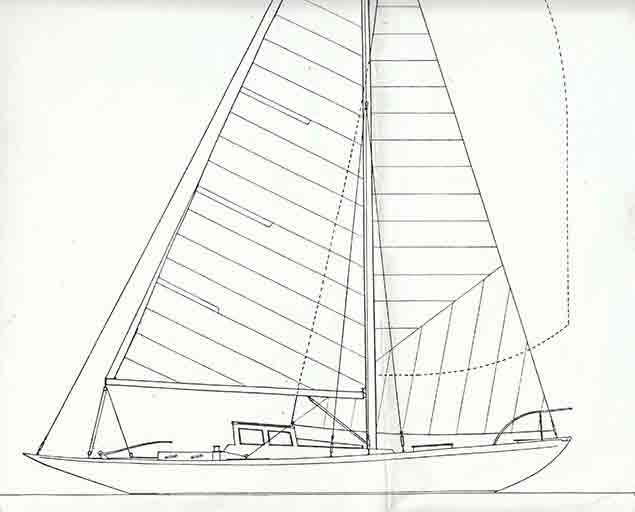 It is 1963, the Old Gaffers Association has just been formed, yet in Dun Laoghaire in 1963 the Dublin Bay 21s make their debut rigged like this……..
It is 1963, the Old Gaffers Association has just been formed, yet in Dun Laoghaire in 1963 the Dublin Bay 21s make their debut rigged like this……..
So is it coming full circle? Maybe. After all, when the America’s Cup multi-hulls start strutting their stuff on Great Sound in Bermuda, they’ll be setting square-headed mainsails which are gaff rig in any sensible definition. And all that where Bermuda rig as we knew it for so long originated more than 183 years ago……
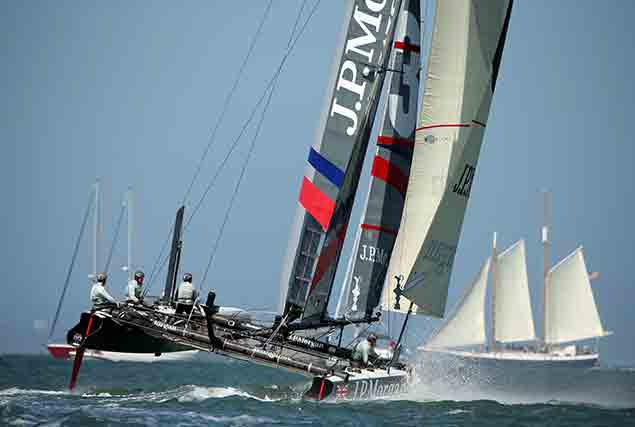 When gaffers meet….one of Ben Ainslie’s America’s Cup boats making knots towards another old gaffer
When gaffers meet….one of Ben Ainslie’s America’s Cup boats making knots towards another old gaffer
But the real test is on Cork Harbour. The reversion to gaff rig came centre stage there last year when the new Ultra National 18s decided the only way to make their otherwise state-of-the-art boats truly sexy was to give them trendy square-topped mainsails.
And if by any chance the spirit of Arthur Sharman Crawford still sails about Cork Harbour, the place he came to love so well, I’ve no doubt he’ll be doing it aboard a ghostly Ierne XXX under a spectral square-topped mainsail, occasionally waxing nostalgic about the old days when he sailed Ierne II with a quaint three-sided mainsail.
 Being fashionable. In 2016, the National 18s Ultras in Cork Harbour reverted to “gaff rig”.
Being fashionable. In 2016, the National 18s Ultras in Cork Harbour reverted to “gaff rig”.
Controversial Irish Challenger Inducted Into America’s Cup 'Hall Of Fame' – After 121 Years
The two America’s Cup Challenges made through the Royal Yacht Squadron by Lord Dunraven of Adare in County Limerick in 1893 and 1895 both had elements of controversy writes W M Nixon. And such serious ill-feeling emerged after his challenge of 1895 that Dunraven was subsequently relieved of his Honorary Membership of the defending New York Yacht Club, an extreme and unprecedented step which led to international diplomatic moves to smooth the waters between the UK and the US.
Dunraven – who had been introduced to sailing by the great John Jameson aboard the famous racing cutter Irex in Dublin Bay in the 1880s – made his challenges with large cutters designed by the renowned G L Watson. And the 1893 matter of potential friction was successfully resolved when Dunraven’s contention that there should not be an inshore course option was successfully upheld in order to ensure truer wind conditions.
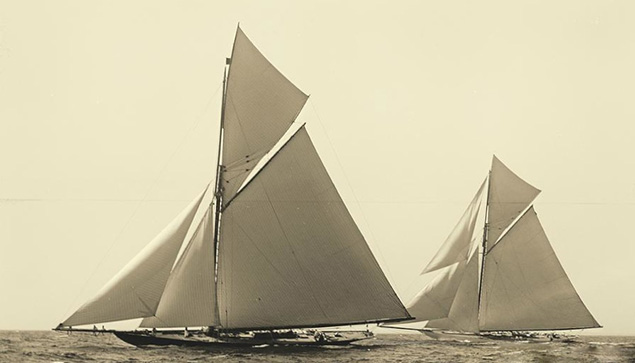 The G L Watson-designed Valkyrie II (left) racing against Vigilant in the 1893 America’s Cup. Valkyrie II was a near-sister of the Royal cutter Britannia which was built the same year
The G L Watson-designed Valkyrie II (left) racing against Vigilant in the 1893 America’s Cup. Valkyrie II was a near-sister of the Royal cutter Britannia which was built the same year
But with the second challenge by the 129ft Valkyrie III in 1895 at New York harbour, he became so incensed by what he felt was the intrusion of the huge spectator fleet into the racing area that he made a formal complaint about about it. And after Valkyrie III was held responsible for minor collision in the second race for which which he tended to blame the spectator fleet, he withdrew from the series with further grievances.
Both the Dunraven challenges ended in defeat, though he was only beaten by 40 seconds in the final race of 1893, with Valkyrie II starting to perform to her true potential. But they had successfully raised the standard of yacht raced in the America’s Cup to a much higher technical level. However, the 1895 effort ended not only in defeat, but with a high level of acrimony which lasted until this year, with the Dunraven challenges almost air-brushed out of some histories of the America’s Cup.
Yet as time has passed a greater realization has developed of Dunraven’s other achievements, for he was a man of many talents – for instance, he successfully co-chaired the Conference which brought Land Act settlement to Ireland in 1903. And some historians of the America’s Cup feel that in the hectic world of the 1890s, the American defenders may have come down a little too heavily on a Challenger who became very isolated in his efforts in 1895 after he had begun to look like a contender in 1893.
Certainly when the next series was held in 1899 – with Sir Thomas Lipton challenging through the Royal Ulster Yacht Cub with Shamrock I – the race area was rigorously patrolled by the US Navy to keep spectator vessels well away. And in later stagings of this pinnacle of world sailing, cognisance was also taken of Dunraven’s feeling that the course should be moved further away from the adverse effects of land upon wind behaviour.
So in this year of 2016, a year in which America seems to be increasingly mired with internal political controversy, it’s good to know that during the summer Windham Thomas Wyndham-Quin, 4th Earl of Dunraven (1841-1926) was finally inducted into the America’s Cup Hall of Fame for his contribution to course-setting protocols, and his pioneering of the Golden Era when huge yet technically-advanced yachts raced for the Holy Grail of international sailing.
Win For Ainslie's Team BAR in Portsmouth
Super Sunday in Portsmouth, double points on offer, excellent flying conditions on the water and thousands of fans thronging on the shoreline. Ben Ainslie’s Land Rover BAR was at the top of the first day leader board and got royal support for the start of day two, with the Duke and Duchess of Cambridge, getting a close up look from the support boat. After the three races it's a win for for the home team and a double celebration as they went to the top of the series lead overall. See video below.
Ainslie Leads in Front of Portsmouth Home Crowd
There were perfect conditions for the thousands of fans who came out to watch the Louis Vuitton America's Cup World Series action close in to shore at Portsmouth yesterday.
Land Rover BAR led in front of their home crowd. See video below.
Dramatic Capsize at Louis Vuitton America’s Cup in Chicago
ORACLE TEAM USA and Emirates Team New Zealand put on a spectacular show in Chicago during official practice at the Louis Vuitton America’s Cup World Series on Friday.
The teams sit one-two on the overall leaderboard, but on Friday, neither team could stay upright. The Kiwis were the first to fall, capsizing late in a close match with ORACLE TEAM USA, the Kiwis came off the foils, crashed down hard, and rolled into a capsize, with some crew members falling off the boat or jumping off the top hull. All crew were safe and accounted for and the Kiwis recovered quickly to start the next race just 15 minutes later.
It was in the next race that ORACLE TEAM USA went over.
The team was well back in the fleet race, and appeared to be surprised by an approaching boat. As skipper Jimmy Spithill rolled into a crash tack to avoid collision, the team didn’t have time to let off a line, pinning the wing sail, and resulting in a capsize.
As with Emirates Team New Zealand, the American team was able to recover and resume racing.
Wing Sail & Foils - America's Cup Yacht Ready for Take Off
The wingsail on ORACLE TEAM USA’s racing yachts and the wings on airplanes operate in similar fashion. As Ian “Fresh” Burns explains, a significant amount of force is generated to propel the boat faster or lift a plane off the ground.
And, the team is utilising the aerodynamic know-how of Airbus to help achieve optimum performance on the water.
Who needs an engine, these days?
America's Cup Spending: Just Over $14 Million
The (Bermuda) Government has spent just over $14 million on the America's Cup as of December 2015, the House of Assembly heard on Friday, with the figures being provided by Minister of Economic Development Dr Grant Gibbons following Parliamentary Questions from MP Wayne Furbert.
According to the Potential Economic Impact [PEI] assessment previously released by the ACBDA, the direct spending on-island for the America's Cup is estimated to be "in the region of approximately $250 million."
In 2009, the Irish Government spent €10m on a stop over and the Green Dragon entry in the Volvo Ocean Race.
Cammas Could Be Back On Board Next Month After Nearly Losing Foot
#FranckCammas - French America's Cup skipper Franck Cammas could be returning to the water as soon as next month after nearing losing his foot in a boating accident late last year.
As previously reported on Afloat.ie, Team France's top man had his right foot "partially severed" when he was run over by the rudder of his foiling catamaran during training in Brittany in late November.
However, after successful surgery Cammas was assured he would not lose the use of his foot as the arteries and nerves were unaffected.
And according to Bermuda's Royal Gazette, the Solitaire veteran and Volvo Ocean Race winner is making significant progress in rehab for his injury.
“Now I can spend more time onshore working with the designers and engineers on the new boat,” he said after having his cast removed last week.
It's thought that Cammas could be back on board in time for the resumption of the America's Cup World Series in Oman on 27-28 February.
The Royal Gazette has more on the story HERE.




























